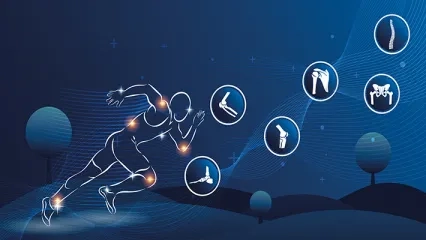Alo Yeditepe
Alo Yeditepe
8 Common Misconceptions About Sports Injuries
One of the keys to a healthier and more active life is sports, but sports for health can make health worse when done unconsciously. Orthopedics and Traumatology specialist Prof. Dr. Hasan Bombacı, who emphasized the importance of exercising consciously and protecting ourselves from injuries as much as possible in order to have the highest level of performance while exercising, explained the mistakes that are thought to be true about sports injuries...
Sport is an activity that is practiced at every stage of life, from childhood, when it is done freely for fun or professional competitions. However, sport creates the risk of injury. Yeditepe University Hospitals Orthopedics and Traumatology specialist Prof. Dr. Hasan Bombacı stated, "However, being aware of the risks while exercising and making the right intervention when an injury occurs will minimize the problems to be encountered in the following periods."
“Running Can Cause Injuries in Knees”
Most sports injuries are preventable injuries. Stating that shoes are often the first thing to be blamed for sports injuries in runners, Prof. Dr. Hasan Bombacı stated, "Shoes are really important. However, as in many other sports branches, some disorders that occur in runners depend on multiple factors. Factors such as running ground, nutrition, dehydration, concentration, and preparation of the body for sports (warm-up-stretching-activity-cool down-stretching again) can all affect the benefit or damage we will get from sports. However, it is possible to prevent most of the potential harms of running, which is a natural activity of most living things."
“Anterior Cruciate Ligament (ACL) Injury Ends an Athlete's Career”
Stating that this information was correct in the past, Yeditepe University Kosuyolu Hospital Orthopedics and Traumatology specialist Prof. Dr. Hasan Bombacı clarified the issue as follows: "Anterior cruciate ligament (ACL) is one of the serious injuries of the knee region. Today, ACL surgeries give much more successful results thanks to developing technology and techniques. However, it is not possible to reduce the process of returning to sports after surgery below certain periods as it is a biological process related to the healing of the ligament. However, with a good rehabilitation process, it is possible to achieve approximately 70-80% return to sports and 50% preoperative performance in patients undergoing ACL reconstruction."
“More Exercise Done To Get Stronger, The Better The Results”
Explaining that it would not be correct to set such definite conclusions for this information, Prof. Dr. Hasan Bombacı stated that there are 2 types of muscle strengthening exercises and provided the following information: "The execution and results of these exercises are different. The first is the exercises that increase the strength and volume of the muscle. In this exercise technique, the exercise is performed against increasing resistance. Meanwhile, the capacity of the muscle to produce energy with the aerobic mechanism gradually decreases and the anaerobic mechanism is activated. Muscle fatigue occurs and some substances released into the muscles cause pain. In the meantime, adaptation mechanisms that are activated in exercises such as heavy lifting, for example, cause an increase in both volume and strength in the muscle. In the second method, the endurance of the muscle increases. Here, the motor units that produce power within the muscle do not increase, but rather the activation of muscles moving in the same direction increases. In this case, the endurance of the muscle, whose volume does not increase much, increases. In strengthening exercises, the technique has an important place in addition to quantity."
“Applying Heat is the Best Way to Relieve Pain in an Acute Injury.”
Tissue damage in a sudden injury sometimes causes bleeding but almost always local edema depending on the severity of the injury. Stating that in cases where bleeding occurs, the vessels will react by shrinking ("vasoconstriction") in order to limit the bleeding in the damaged area, Prof. Dr. Bombacı stated, "Subsequently, other mechanisms to stop bleeding are activated. In the following hours, in response to the lack of oxygen in that area, dilation of the vessels and an increase in vascular permeability occur, which means an increase in edema": "If heat is applied at the beginning of the injury, bleeding and edema increase in the damaged area due to the expansion of the vessels. This is also an undesirable situation. Instead, the cold press should be applied to the damaged area "
“Exercise Must Be Painful To Be Beneficial!”
Underlining that this information is not always correct, Prof. Dr. Hasan Bombacı informed that the most important reason for the pain felt during exercise is the irritation caused by lactic acid that occurs during muscle contraction. Prof. Dr. Bombacı said that this is especially evident in exercises against high resistance, such as lifting weights, and added: "The reason for this is that when the capacity of the muscle is used the most, the mechanism of energy production in the muscle switches from the 'aerobic pathway' to the 'anaerobic pathway'. Forcing to these limits is necessary to increase both the volume and the number of muscle cells. This occurs, but to a lesser degree, in endurance exercises where the muscles work below maximum strength. In stretching exercises, another type of exercise, the pain caused by the exercise is felt at the beginning of the exercise, but it is shorter.
Underlining that this information is not always correct, Prof. Dr. Hasan Bombacı informed that the most important reason for the pain felt during exercise is the irritation caused by lactic acid that occurs during muscle contraction. Prof. Dr. Bombacı said that this is especially evident in exercises against high resistance, such as lifting weights, and added: "The reason for this is that when the capacity of the muscle is used the most, the mechanism of energy production in the muscle switches from the 'aerobic pathway' to the 'anaerobic pathway'. Forcing up to these limits is necessary to increase both the volume and the number of muscle cells. However, in endurance exercises, where the muscles work below maximum strength, this occurs, but to a lesser degree. In stretching exercises, another type of exercise, the pain caused by the exercise is felt at the beginning of the exercise, but it is shorter.
“A Dislocated Finger Takes Longer to Heal than a Broken One”
Pointing out that the treatment approach for finger dislocations will differ according to the hand or foot, Prof. Dr. Hasan Bombacı stated, "If we talk about the more common hand fractures and dislocations, it would not be wrong to say that very different results may occur depending on the complex structure of the hand and the variety of damage that will occur" and emphasized that both fractures and dislocations can be treated with non-surgical treatments called conservative treatment, as well as various surgical procedures depending on the location and shape of the fracture and dislocation. Prof. Dr. Bombacı added that the healing process may vary greatly in both injuries depending on the location and shape of the fracture and dislocation.
“Ankle Sprain Is Worse Than Ankle Fracture”
Ankle sprain: Ligament injuries that occur in the ankle joint, are very common in daily life. , Prof. Dr. Hasan Bombacı also stated the following: "Although it is not very common, it may be accompanied by small fractures. Unless there is a fracture, the treatment of ankle sprain (ligament injury) for the first time is a fixation with specially designed orthoses for varying periods depending on the degree of ligament damage. Fractures of the ankle are basically caused by abnormal loading of the ankle. However, in this case, fractures occur in one or more bones forming the ankle. In the treatment, surgery is mostly required. Sometimes these fractures may be accompanied by cartilage damage. Therefore, the results are more unpredictable and carry risk."
“Weight-lifting Exercises In Pre-adolescents and Adolescents Causes Injuries In the Growth Plates and Causes Decline In Growth”
Underlining that this information is not always correct, Yeditepe University Kosuyolu Hospital Orthopedics and Traumatology specialist Prof. Dr. Hasan Bombacı reminded that muscle volume and oxygen burning capacity of muscles are less in pre-puberty children compared to adults and added "This causes the muscles to produce less power. Therefore, children get tired more quickly. Early fatigue of the muscles indirectly means that the joints and the growth plates at the ends of the long bones are overloaded. This can lead to injury to the growth cartilage. However, recent studies show that the risks to the growth plates can be minimized with well-organized and timed (8-12 weeks) exercise programs in children. In strengthening exercises performed by children, exercises performed with more repetitions against lower resistance are more appropriate."
Press Coverage: cumhuriyet | mynet | korkusuz | milliyet | star | sabah | haberler | yenicaggazetesi | kadikoylife | yenicaggazetesi
About
Faculty and Year of Graduation:
İstanbul Faculty of Medicine, 1986
”
See Also
- What are Hip Joint Diseases? Causes and Treatment
- Robotic Hip Replacement Surgery
- What is Hallux Rigidus (Stiff Big Toe/Toe Arthritis)? Symptoms and Treatment
- What is Hallux Valgus (Bunion)? How is it Treated?
- Ergonomics in Automobiles Prevents Accidents
- Walking and Returning to Social Life After Knee Replacement Surgery
- What Are the Advantages of Robotic Knee Replacement Surgery?
- Robotic Knee Prosthesis Surgery
- The Usage Area of Robotic Surgery Expands in Orthopedic Surgeries
- Higher Risk of Anterior Cruciate Ligament and Ankle Injury in Female Athletes
- Spinal Fractures
- Big Toes Can Be A Big Problem!
- Hip Osteoarthritis and Hip Prosthesis
- Not Only Athletes Suffer from Meniscus Tears!
- Mistakes While Swimming Can Cause Shoulder Pain
- Myths About Fractures
- The First Onset of Pain in Cartilage Damage in the Knee Should Not Be Overlooked
- Sports Injuries
- Knee Arthritis
- Knee Pain
- Treatment of Knee Arthrosis Varies According to the Person
- A Lack of Attention to Sports Injuries in Children May Affect Their Development
Alo Yeditepe




